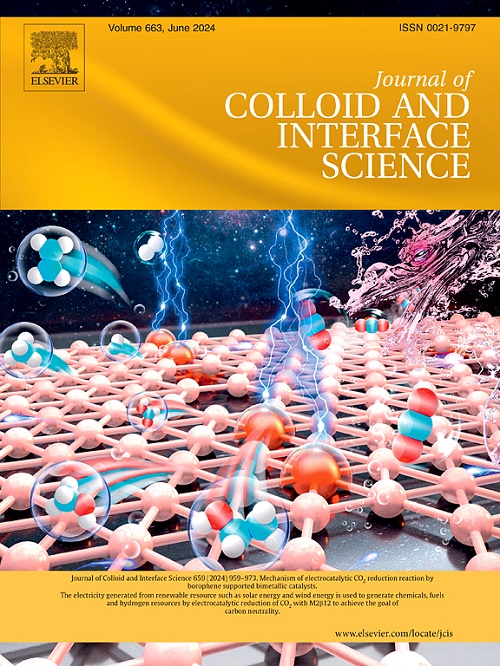壳聚糖双网水凝胶协同光热/一氧化氮治疗耐甲氧西林金黄色葡萄球菌感染创面愈合
IF 9.7
1区 化学
Q1 CHEMISTRY, PHYSICAL
引用次数: 0
摘要
先进的伤口敷料的发展,包括协同抗菌策略是解决抗生素耐药感染和促进组织再生至关重要。本研究提出了一种近红外(NIR)响应双网络水凝胶(Gel@HS),结合光热疗法(PTT)和一氧化氮(NO)气体疗法治疗耐甲氧西林金黄色葡萄球菌(MRSA)感染伤口。利用壳聚糖的天然组织粘附性和抗菌性能,以丙烯酰胺为一级网络,壳聚糖(一种碳水化合物聚合物)为二级网络。在近红外照射下,加入中空硫化铜纳米颗粒(HCuS)和硝普钠(SNP)实现光热转化和控制NO释放。该水凝胶表现出卓越的机械稳定性、粘附性和靶向抗菌活性,通过ptt诱导的膜破坏和no介导的蛋白失活促进细菌清除。体外实验证实其广谱抗菌(消除99% MRSA)和通过巨噬细胞调节的抗炎作用。使用mrsa感染的小鼠伤口模型进行的体内测试显示,伤口愈合加速(9天内伤口愈合93%),细菌负荷减少,炎症细胞因子水平降低。这项研究强调了碳水化合物聚合物基水凝胶作为对抗耐药感染和通过物理化学协同作用促进伤口愈合的多功能平台的潜力。本文章由计算机程序翻译,如有差异,请以英文原文为准。

Chitosan-based double-network hydrogel with synergistic photothermal/nitric oxide therapy for methicillin-resistance Staphylococcus aureus infected wound healing
The development of advanced wound dressings that incorporate synergistic antibacterial strategies is essential for addressing antibiotic-resistant infections and facilitating tissue regeneration. This study presents a near-infrared (NIR)-responsive double-network hydrogel (Gel@HS) that combines photothermal therapy (PTT) and nitric oxide (NO) gas therapy for the treatment of methicillin-resistant Staphylococcus aureus (MRSA)-infected wounds. The hydrogel was engineered with acrylamide as the primary network and chitosan, a carbohydrate polymer, as the secondary network, capitalizing on chitosan's natural tissue adhesion and antibacterial properties. Hollow copper sulfide nanoparticles (HCuS) and sodium nitroprusside (SNP) were incorporated to enable photothermal conversion and controlled NO release upon NIR irradiation. The hydrogel demonstrated remarkable mechanical stability, adhesion, and targeted antibacterial activity, facilitating bacterial eradication through PTT-induced membrane disruption and NO-mediated protein inactivation. In vitro experiments confirmed its broad-spectrum antibacterial efficacy (>99 % MRSA elimination) and anti-inflammatory effects via macrophage modulation. In vivo testing using an MRSA-infected murine wound model showed accelerated healing (93 % wound closure within 9 days), reduced bacterial load, and diminished inflammatory cytokine levels. This research highlights the potential of carbohydrate polymer-based hydrogels as multifunctional platforms for combating resistant infections and promoting wound healing through physicochemical synergy.
求助全文
通过发布文献求助,成功后即可免费获取论文全文。
去求助
来源期刊
CiteScore
16.10
自引率
7.10%
发文量
2568
审稿时长
2 months
期刊介绍:
The Journal of Colloid and Interface Science publishes original research findings on the fundamental principles of colloid and interface science, as well as innovative applications in various fields. The criteria for publication include impact, quality, novelty, and originality.
Emphasis:
The journal emphasizes fundamental scientific innovation within the following categories:
A.Colloidal Materials and Nanomaterials
B.Soft Colloidal and Self-Assembly Systems
C.Adsorption, Catalysis, and Electrochemistry
D.Interfacial Processes, Capillarity, and Wetting
E.Biomaterials and Nanomedicine
F.Energy Conversion and Storage, and Environmental Technologies

 求助内容:
求助内容: 应助结果提醒方式:
应助结果提醒方式:


